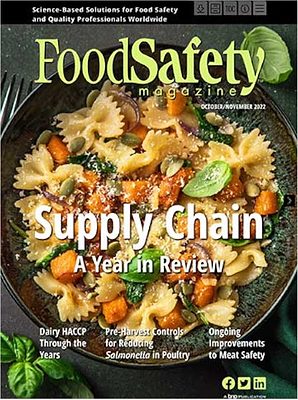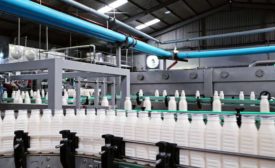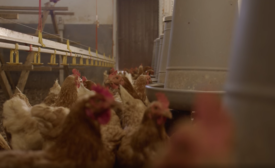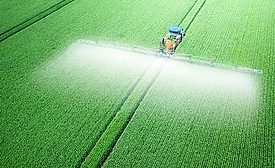Home » Publications » Food Safety Magazine
Our Publications
Please select a publication below.
Food Safety Magazine

October/November 2022
Features
Back to TopTo understand supply chain disruptions in a more systematic way, broader scenario planning and more rigorous work processes are needed
Read More
Dairy HACCP Through the Years
The dairy industry has seen many regulatory changes, including the incorporation of the FSMA Preventive Controls Rule within the Pasteurized Milk Ordinance
October 11, 2022
Ongoing Improvements to Meat and Poultry Safety
The author examines five current topics in meat and poultry and their implications to protein food
October 11, 2022
Columns
Back to TopThe Incident Command System and Foodborne Illness Outbreak Investigations
The Coordinated Outbreak Response and Evaluation (CORE) Network is the coordination focal point for all FDA resources during outbreak investigations
October 11, 2022
Navigating U.S. Federal and State Regulation of PFAS in Applications Involving Food
PFAS restrictions and bans are not consistent, and determining compliance presents numerous challenges
October 11, 2022
Sanitation Prerequisite Programs as a Necessary Component of FSMS for Foodservice Establishments
It is imperative that a paradigm shift happens now in how risk is managed in foodservice establishments
October 11, 2022
Evolving Relationships Between Food Processors and Regulatory Agencies
Processors speak out about how they are coping with regulatory demands now that FDA has resumed in-person inspections
October 11, 2022
Demystifying Pesticide Residues
To determine acceptable pesticide residue risk levels, we rely on a risk assessment framework to make science-based decisions
October 11, 2022
Global Food Safety Culture: Latin America
Latin America leans toward indirect, high-context communication and relationship-based culture
October 11, 2022
Reanalysis—A Critical Component of Verification
The Food Safety Plan/HACCP Plan is a living document that requires ongoing maintenance, including reanalysis at appropriate time intervals
October 11, 2022
How Restaurant Operators can Handle Food Poisoning Allegations
Restaurants must handle foodborne illness claims professionally, and a framework for investigating consumer food poisoning allegations must be in place
October 11, 2022
Never miss the latest news and trends driving the food safety industry
eNewsletter | Website | eMagazine
JOIN TODAY!Copyright ©2025. All Rights Reserved BNP Media.
Design, CMS, Hosting & Web Development :: ePublishing

















